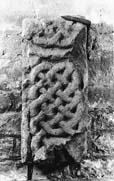Select a site alphabetically from the choices shown in the box below. Alternatively, browse sculptural examples using the Forward/Back buttons.
Chapters for this volume, along with copies of original in-text images, are available here.
Object type: Part of cross-shaft and -head
Measurements: L. 58 cm (22.8 in) W. 25 > 24 cm (9.8 > 9.4 in) D. 20 cm (7.9 in)
Stone type: Brownish yellow (10YR 7–8/3) oolite grainstone, composed of closely packed ooliths of around 0.4mm diameter (range 0.3 to 0.5mm). Ancaster Freestone, Upper Lincolnshire Limestone, Inferior Oolite Group
Plate numbers in printed volume: Ills. 41–2
Corpus volume reference: Vol 5 p. 107
(There may be more views or larger images available for this item. Click on the thumbnail image to view.)
A fragment from the upper shaft of a small standing cross. The stone has been recut on three faces, removing much of the cross-head. Decoration only survives on the remaining broad face. The angles of the shaft are undecorated and of sub-circular section. There is a broken socket hole in the lower end.
A (broad): (i) On the shaft, the remains of a panel of interlace in low relief. The interlace is divided into (at least) two registers by a return near what was probably the centre of the shaft. The surviving unit is a grid of six-cord plait, with two free ends at the top. The strands are of rectangular section. (ii) The cross-head was also decorated with interlace, divided from that in the shaft by a roll moulding. All that survives of this interlace are the two loops which occupy the terminal of the lower cross-arm. The decoration must have been of the type surviving at several sites discussed below, although it is not possible to say whether this head had pierced interstices or was a solid disc.
The undecorated borders associate the Bicker 1 shaft with the South Kesteven cross type (Chapter V), but it should be distinguished from this group as it is cut in a stone type similar to Ancaster. The cross-head decoration evidenced at Bicker is found both in examples from the South Kesteven shaft group (e.g. Elloe Stone, Ills. 171–2) and also on monuments which, though related in concept, are from different production centres (e.g. Colsterworth 2, Lincoln St Mark 1 and Lincoln St Mary-le-Wigford 1; Ills. 92–3, 235–7, 265–6). The well laid-out interlace grid associates Bicker 1 with the shaft of similar size at North Witham (no. 1, Ills. 315–16), though this also has interlace decoration on the sides and the angles have cable moulding.
Bicker 1, then, represents a small monument which appears to belong to the group of shafts which, though related through their form and decoration to the South Kesteven shaft group, were produced at other production centres. Amongst these monuments the Bicker shaft finds its closest comparison with North Witham 1, which has similarities with the Ancaster quarry products and is considered to date from the early eleventh century.



